Structural Behavior of L-Type Flange Joint with Various Flange Flatness Conditions
Abstract
:1. Introduction
2. Experimental Study
2.1. L-Type Flange Joint Test
2.1.1. Test Specimen
2.1.2. Data Measurement Plan
2.1.3. Two Loading Steps
2.2. Test Results and Observations
2.2.1. Force–Displacement Relationship
2.2.2. Failure Modes
3. Numerical Simulation
3.1. Modelling of 5 MW L-Type Flange Joint
3.2. Validation of the Finite Element Model
- The finite element model assumes ideal contact between the components of the joint, such as the bolt/nut, flange/washers, etc. In contrast, the manual assembly of the test may result in imperfect contact between these components, leading to an inaccuracy in the test results comparison.
- The fastening process may have caused the flange members to rotate, thereby leading to a decrement in the clamping solid stiffness. This rotation may have further contributed to the difference between the experimental and simulation curves.
4. Parametric Study
4.1. Influence of Geometrical Imperfect Flange Models
4.1.1. Structural Response of the Flange Member
- The contact pressure between the flange parts is first discussed. Under bolt pretension, a clamping pressure is established between the two flange members. The pressure increases from the left side to the right side of the flange surface. In the perfect model, the pressure is highest at the flange inner (83 MPa). For imperfection cases, higher pressures of 85 MPa and 87 MPa are found for the flange-sided and tower-sided gapping cases, respectively. Under the tensile load, the upper and lower flanges are separated, resulting in zero pressure at the flange outer and high pressure at the flange inner.
- Regarding axial stress, stress concentration occurs at the surface contact between the flanges and washers under a bolt pretension load. With the perfect model, the highest compressive stress of 399 MPa is found in the bolt hole. An increase of 7.0% and 27.0% in stress is observed in the cases of flange-sided and tower-sided gaps, respectively, compared to the perfect condition. These values exceed the yield strength of the material specified in Section 2.1.1, which increases the risk of failure close to the center of the bolt hole. Under tensile load, there is considerable compressive stress at the flange tip, which is consistent with the pressure distribution between the two flange members. A value of 359 MPa is found for the perfect condition, and little change is observed when considering the skew effects (1.1%).
- When the tower is subjected to tensile load, a high stress of 335 MPa occurs at this location. This stress increases considerably in the case of flange-sided gaps, with an increase of about 9.5%.
- The compressive stress observed at the flange inner area and bolt hole, as well as the tensile stress observed at the FSJ, exceeds the material yielding strength specified in Section 2.1.1, which can lead to yielding in the flange joint. However, it is worth noting that the compressive stress yielding is less significant compared to the tensile zone, as the flange has a high thickness in that area.
4.1.2. Structural Response of the Bolt Member
- In a perfect model, the stress is distributed symmetrically in the bolt during the pretension process, with very little stress concentration at the bolt thread (1193 MPa). However, for flange-sided gaps, bending-induced stress increases, resulting in a larger stress amplitude on the bolt’s left side. In contrast, a larger stress amplitude is observed on the right side of the shank and bolt thread in the case of the tower-sided gap.
- Under the tensile load, similar stress distributions are found in the bolt members. In the perfect model, the stress distributes symmetrically in the bolt. The stress concentration occurs at the bolt head and thread area, with a maximum value of 1486 MPa. However, there is a clear difference when considering the flange surface flatness. Looking at the flange-sided gap, the area going through stress concentration is much larger when compared to the perfect model, with an increase of 6.3%. For the tower-sided gap, more stress concentration seems to occur in the bolt. These stress areas may play a significant role in the fatigue assessment [27,28,29].
- There is a slight plastic deformation observed in the bolt during the preloading. However, the area going through the plastic strain zone increases considerably under the tensile load. Notably, there is an increased number of threads subject to plastic deformation in the case of the tower-sided gap (see Figure 15).
4.2. Influence of the Flange Opening Length
4.2.1. Structural Response of the Flange Member
- The surface contact between the flanges and washers causes stress concentration with a stress of 411 MPa for Li = 100 mm. This stress slightly increases with increasing the opening length by up to 5.6%.
- When the tower shell is subjected to tensile load, a significant area of compressive stress appears at the internal flange tip, reaching a value of around 335 MPa for all cases (as shown in Figure 16) due to the separation of the flange members. Another finding is the tensile stress distribution at the FSJ, about 328 MPa for Li = 100 mm. The stress concentration becomes wider as the opening becomes larger. For instance, when Li = 210 mm, the stress is 11.9% higher than in the other cases.
- When the opening is located in the center of the bolt hole (Li = 100 mm), it is evident that the bolt hole experiences very high compressive stress (reaching a value of 585 MPa), leading to the flange yielding (as shown in Figure 17).
4.2.2. Structural Response of the Bolt Member
- Under the bolt pretension load, the maximum stress of 1230 MPa occurs at the opening length of Li = 100 mm. The stress increases by 9.9% and 13.8% at Li = 150 mm and Li = 210 mm, respectively. Additionally, wider regions of stress concentration are observed in the bolt with larger opening lengths.
- For the tensile load, the maximum stress at Li = 100 mm is approximately 1507 MPa. There is a small change in maximum stress with increasing opening length, up to 4.8%. Furthermore, higher stresses are concentrated on the bolt’s left side due to its bending, and a wider region of stress concentration occurs as the opening length increases.
- The plastic strain increases as the opening length becomes larger, and there is a larger area that goes across the bolt threads.
4.3. Discussions
- For the flange member, compressive stress concentration appears in the flange inner and surface between the flange and washer, and the tensile stress concentration occurs at the FSJ. When the opening is located at the center of the bolt hole, the compressive stress concentration increases rapidly in the bolt hole. However, these regions of compressive stress are not as significant as other parts due to the flange thickness.
- For the bolt member, the stress concentration often occurs at the threads and bolt shank. The tower-sided gap has a significant impact on bolt stress. As the opening length increases, wider stress concentrations are found in the bolt due to the increase in bending moment.
5. Conclusions
- Geometrical imperfections cause a local bending in the bolt, leading to a significant difference in bolt performance between the perfect and imperfect models. Imperfect models have a larger stress concentration area under bolt preloading and tower shell tensile loading, with a 6.3% increase in the maximum stress.
- Flange-sided gap case performs better than the tower-sided gap case, as the former results in less plastic deformation in the bolt threads due to the flange surface flatness.
- Increasing the flange gap opening length significantly increases the stress in the flange joint, with an 11.9% and 13.8% increase in stress for the flange and bolt members, respectively. This also causes a shift in global stress from the middle bolt toward the bolt head.
Author Contributions
Funding
Data Availability Statement
Conflicts of Interest
References
- Schaumann, P.; Seidel, M. Failure Analysis of Bolted Steel Flanges. In Proceedings of the Seventh International Symposium on Structural Failure and Plasticity (IMPLAST2000), Melbourne, Australia, 4–6 October 2000; pp. 507–512. [Google Scholar]
- Alonso-Martinez, M.; Adam, J.M.; Alvarez-Rabanal, F.P.; del Coz Díaz, J.J. Wind Turbine Tower Collapse Due to Flange Failure: FEM and DOE Analyses. Eng. Fail. Anal. 2019, 104, 932–949. [Google Scholar] [CrossRef]
- Seidel, M.; Stang, A.; Wegener, F.; Schierl, C.; Schaumann, P. Full-Scale Validation of FE Models for Geometrically Imperfect Flange Connections. J. Constr. Steel Res. 2021, 187, 106955. [Google Scholar] [CrossRef]
- Okorn, I.; Nagode, M.; Klemenc, J.; Oman, S. Analysis of Additional Load and Fatigue Life of Preloaded Bolts in a Flange Joint Considering a Bolt Bending Load. Metal 2021, 11, 449. [Google Scholar] [CrossRef]
- Weijtjens, W.; Stang, A.; Devriendt, C.; Schaumann, P. Bolted Ring Flanges in Offshore-Wind Support Structures-in-Situ Validation of Load-Transfer Behaviour. J. Constr. Steel Res. 2021, 176, 106361. [Google Scholar] [CrossRef]
- Tran, T.-T.; Lee, D. Ultimate Load Capacity Assessment of the L-Type Flange Connection of An Existing 5 MW Wind Tower. In Proceedings of the Asia-Pacific Forum on Renewable Energy, Jeju, Republic of Korea, 7–11 November 2021; p. 146. [Google Scholar]
- Seidel, M. Zur Bemessung Geschraubter Ringflanschverbindungen Von Windenergieanlagen; Leibniz Universität Hannover: Hanover, Germany, 2001. [Google Scholar]
- Thage, K.J. Investigation of Flange Connection Capacity for Offshore Wind Turbine Foundations; Technical University of Denmark: Kongens Lyngby, Denmark, 2017. [Google Scholar]
- Petersen, C. Tragfähigkeit Imperfektionsbehafteter Geschraubter Ringflansch-Verbindungen. Der Stahlbau 1990, 59, 97–104. [Google Scholar]
- Veljkovic, M.; Heistermann, C.; Husson, W.; Limam, M.; Feldmann, M. High-Strength Tower in Steel for Wind Turbines (HISTWIN); European Commission Joint Research Centre: Brussels, Belgium, 2009. [Google Scholar]
- Petersen, C. Stahlleichtbau. In Stahlbau; Springer: Wiesbaden, Germany, 2013. [Google Scholar] [CrossRef]
- Couchaux, M.; Hjiaj, M.; Ryan, I.; Bureau, A. Tensile Resistances of L-Stubs. J. Constr. Steel Res. 2017, 138, 131–149. [Google Scholar] [CrossRef]
- Tran, T.-T.T.; Lee, D. Understanding the Behavior of L-Type Flange Joint in Wind Turbine Towers: Proposed Mechanisms. Eng. Fail. Anal. 2022, 142, 106750. [Google Scholar] [CrossRef]
- Ślęczka, L.; Leń, D. Prying Action in Bolted Circular Flange Joints: Approach Based on Component Method. Eng. Struct. 2021, 228, 111528. [Google Scholar] [CrossRef]
- Tobinaga, I.; Ishihara, T. A Study of Action Point Correction Factor for L-Type Flanges of Wind Turbine Towers. Wind Energy 2018, 21, 801–806. [Google Scholar] [CrossRef]
- Ji, X.; Zou, T.; Bai, X.; Niu, X.; Tao, L. Fatigue Assessment of Flange Connections in Offshore Wind Turbines under the Initial Flatness Divergence. Front. Energy Res. 2023, 11, 137. [Google Scholar] [CrossRef]
- Jakubowski, A. Ermüdungssichere Bemessungen Geschraubter Ringflanschstöße in Turmartigen Stahlbauten Unter Besonderer Berücksichtigung von Flanschimperfektionen; Cuvillier Verlag: Göttingen, Germany, 2003; Available online: https://cuvillier.de/de/shop/publications/3323 (accessed on 25 July 2023).
- Zou, T.; Niu, X.; Ji, X.; Li, M.; Tao, L. The Impact of Initial Imperfections on the Fatigue Assessment of Tower Flange Connections in Floating Wind Turbines: A Review. Front. Mar. Sci. 2022, 9, 1–16. [Google Scholar] [CrossRef]
- DNVGL-ST-0126; Support Structures for Wind Turbines. DNV GL: Bærum, Norway, 2018. Available online: https://www.dnv.com/energy/standards-guidelines/dnv-st-0126-support-structures-for-wind-turbines.html (accessed on 25 July 2023).
- IEC 61400-6; Wind Energy Generation System-Part 6: Tower and Foundation Design Requirements. 2020. Available online: https://webstore.iec.ch/publication/26383 (accessed on 25 July 2023).
- Seidel, M. Tolerance Requirements for Flange Connections in Wind Turbine Support Structures. Stahlbau 2018, 87, 880–887. [Google Scholar] [CrossRef]
- KATS KSB 0802; Steel Welding Pipe Flanges. Korean Agency for Technology and Standards: Eumseong-gun, Republic of Korea, 2021.
- KATS KSB 0801; Test Pieces for Tensile Test for Metallic Materials. Korean Agency for Technology and Standards: Eumseong-gun, Republic of Korea, 2022.
- EN-1993-1-8; Eurocode 3: Design of Steel Structures-Part 1–8: Design of Joints. European Standard: Bruxelles, Belgium, 2011.
- DNVGL-RP-C208; Determination of Structural Capacity by Non-Linear Finite Element Analysis Methods. DNV GL: Bærum, Norway, 2013. Available online: https://www.dnv.com/oilgas/download/dnv-rp-c208-determination-of-structural-capacity-by-non-linear-finite-element-analysis-methods.html (accessed on 25 July 2023).
- Tran, T.T.; Kang, S.; Lee, D. Improving Structural Safety of L-Type Flange Joint for Wind Towers. Energies 2022, 15, 8967. [Google Scholar] [CrossRef]
- Masoudi Nejad, R.; Berto, F.; Tohidi, M.; Jalayerian Darbandi, A.; Sina, N. An Investigation on Fatigue Behavior of AA2024 Aluminum Alloy Sheets in Fuselage Lap Joints. Eng. Fail. Anal. 2021, 126, 105457. [Google Scholar] [CrossRef]
- Shariati, M.; Nejad, R.M. Fatigue Strength and Fatigue Fracture Mechanism for Spot Welds in U-Shape Specimens. Lat. Am. J. Solids Struct. 2016, 13, 2487–2501. [Google Scholar] [CrossRef] [Green Version]
- Badrkhani Ajaei, B.; Soyoz, S. Effects of Preload Deficiency on Fatigue Demands of Wind Turbine Tower Bolts. J. Constr. Steel Res. 2020, 166, 105933. [Google Scholar] [CrossRef]
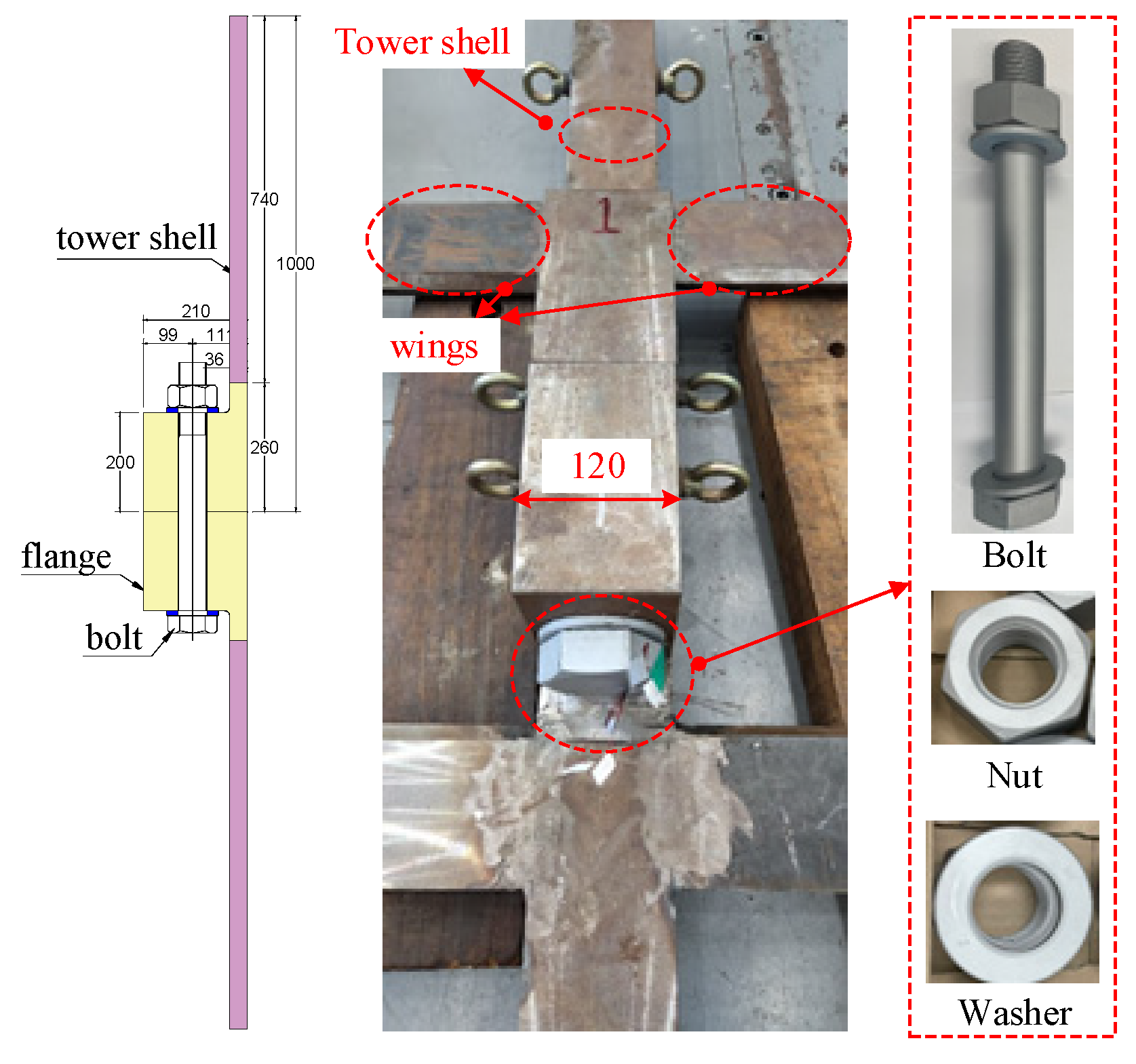
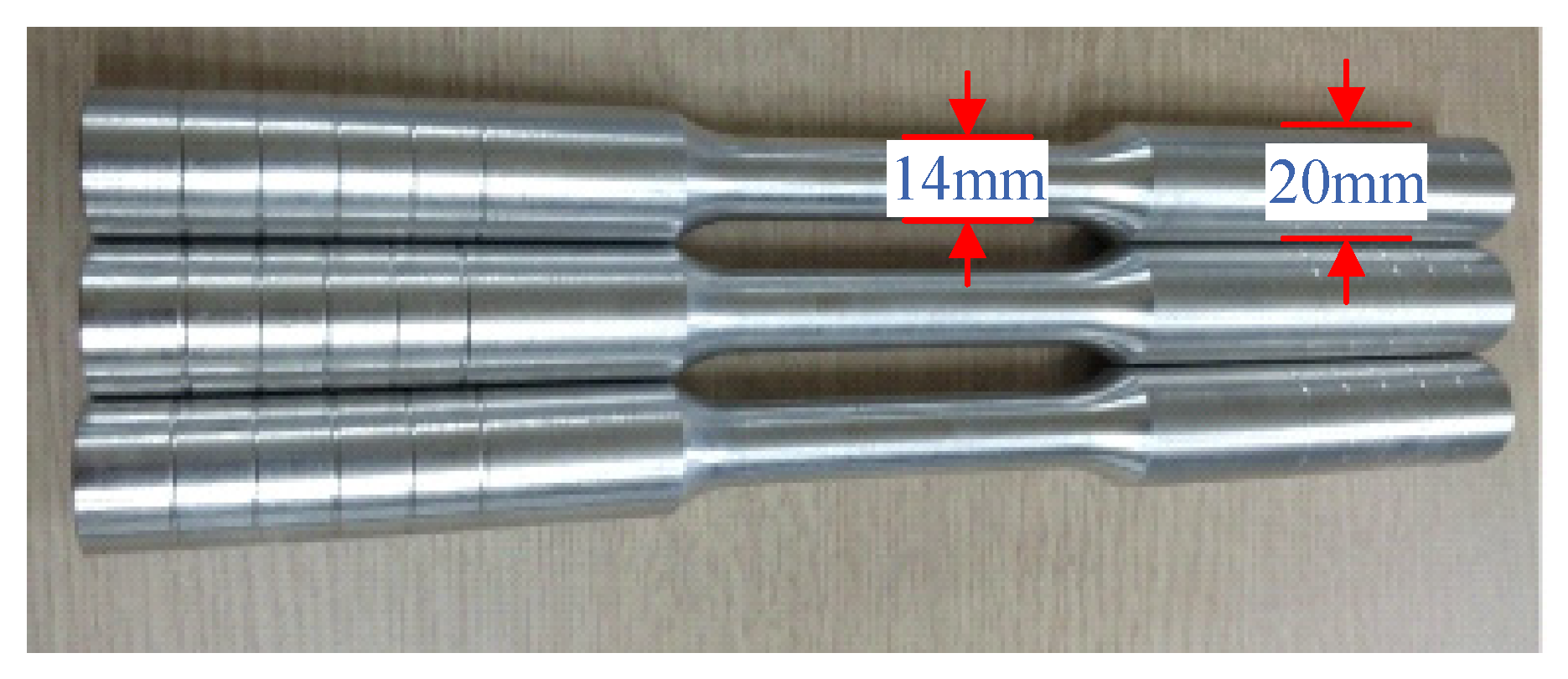
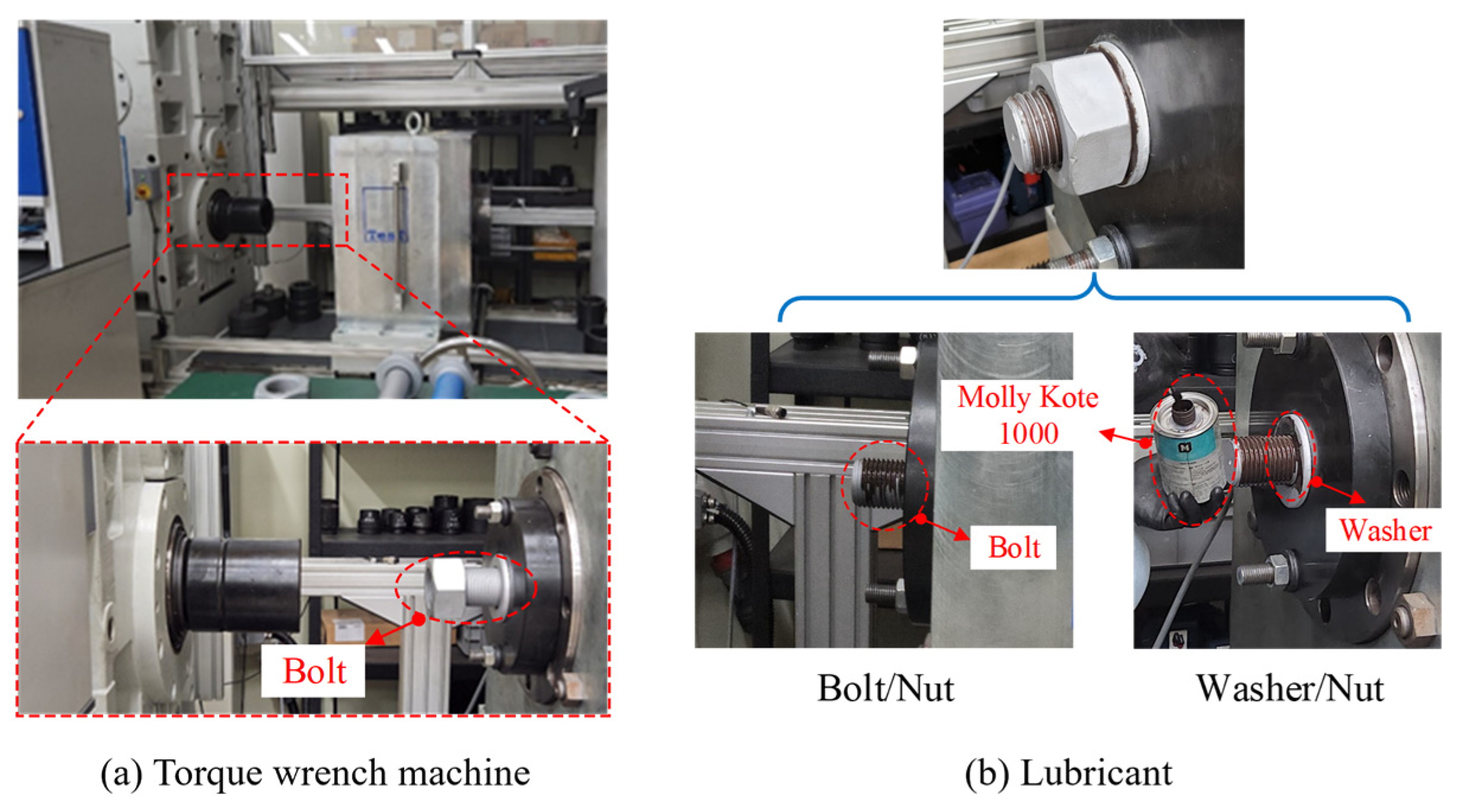
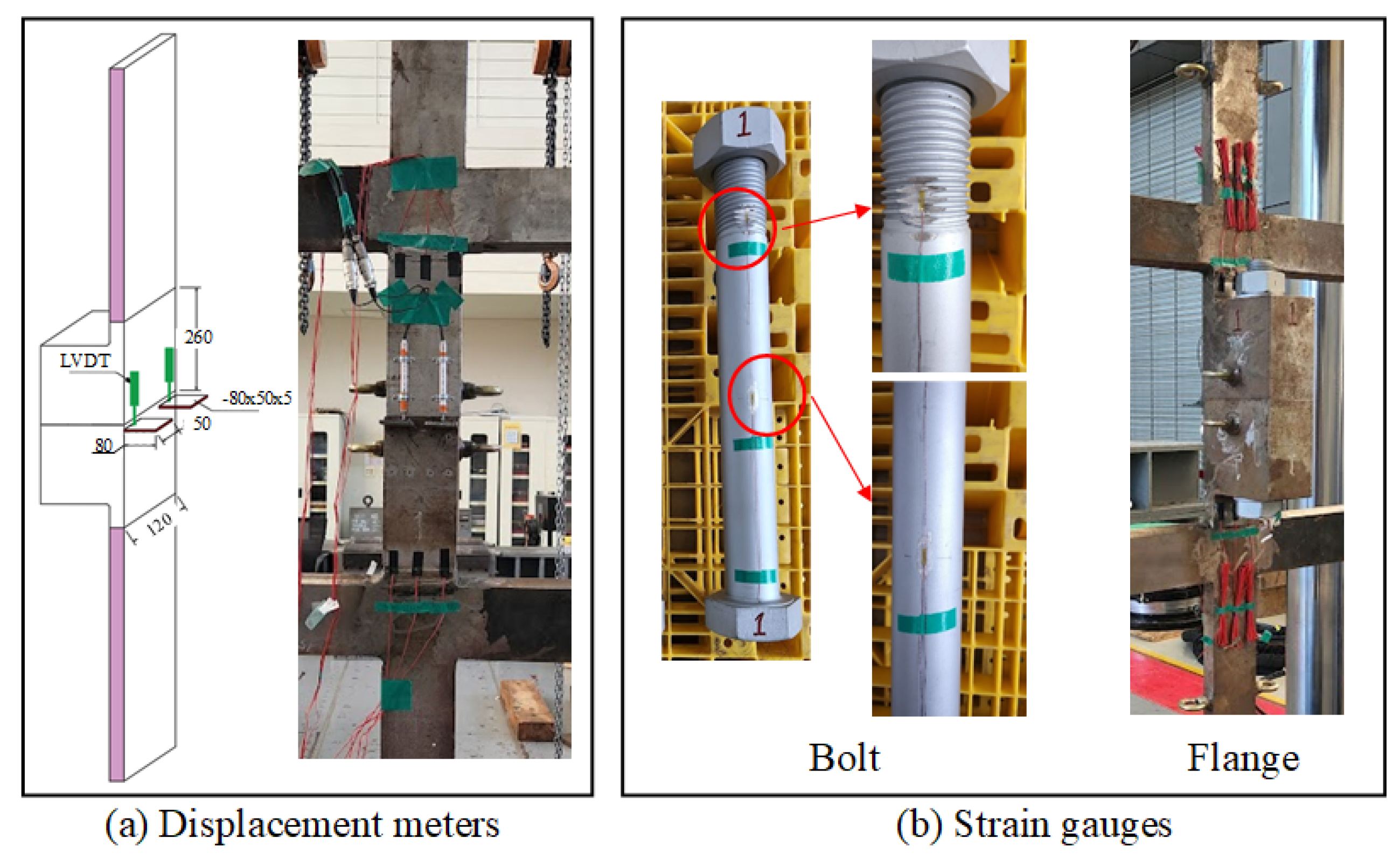
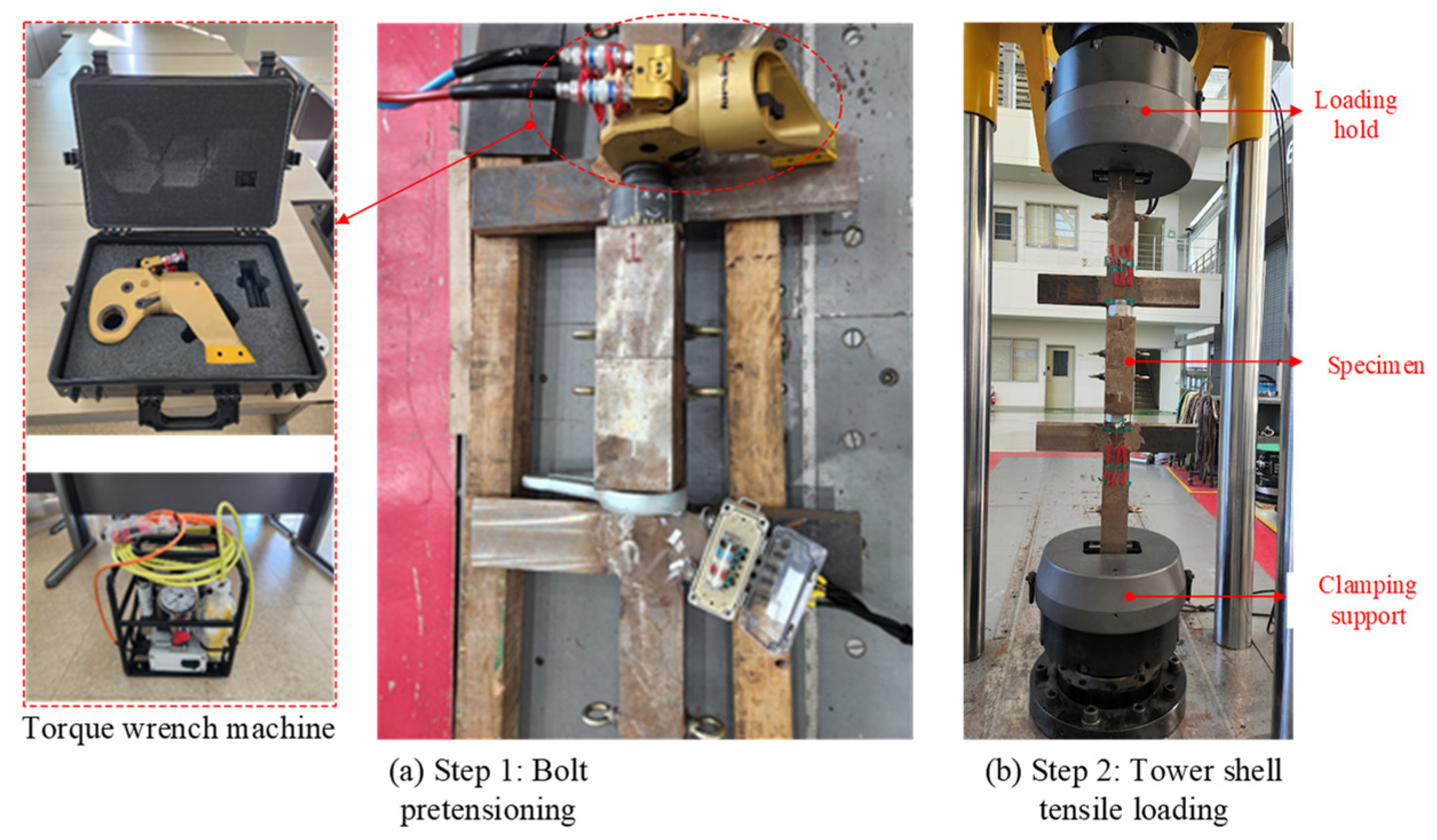


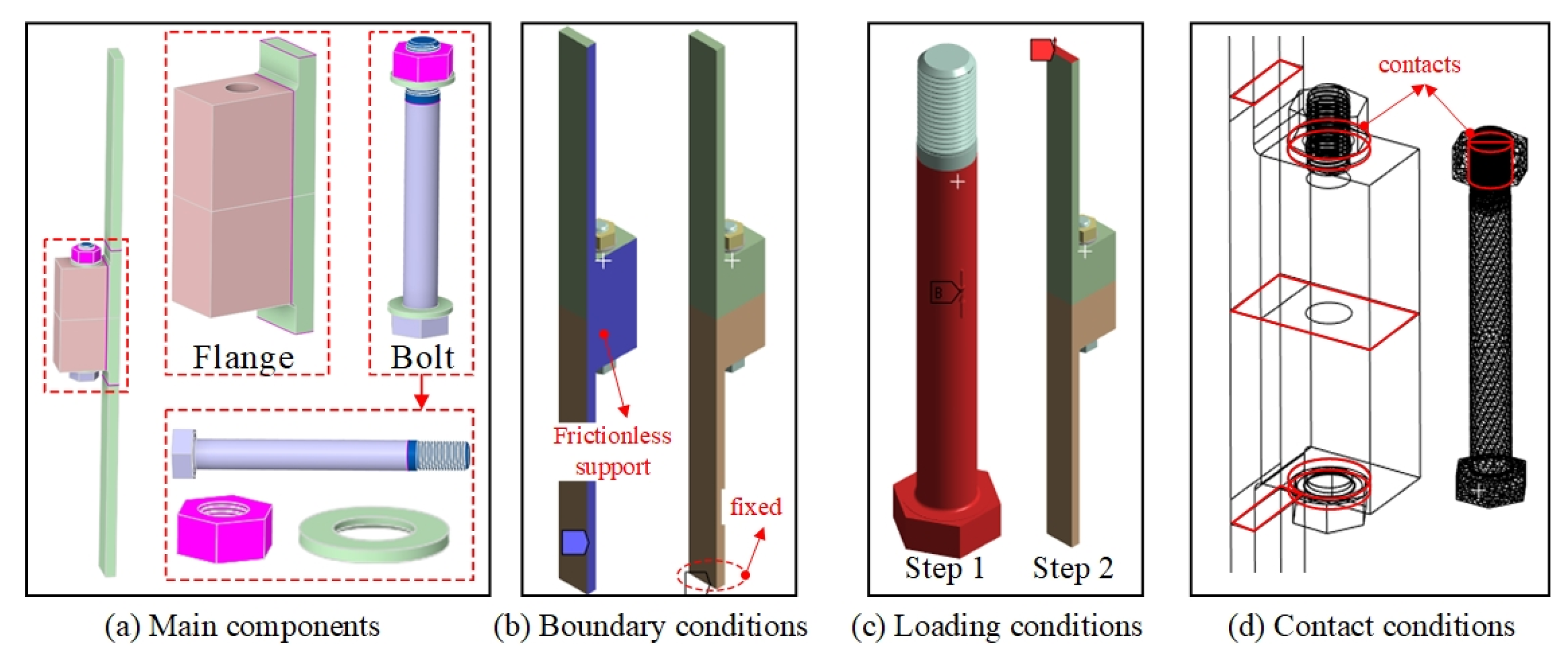

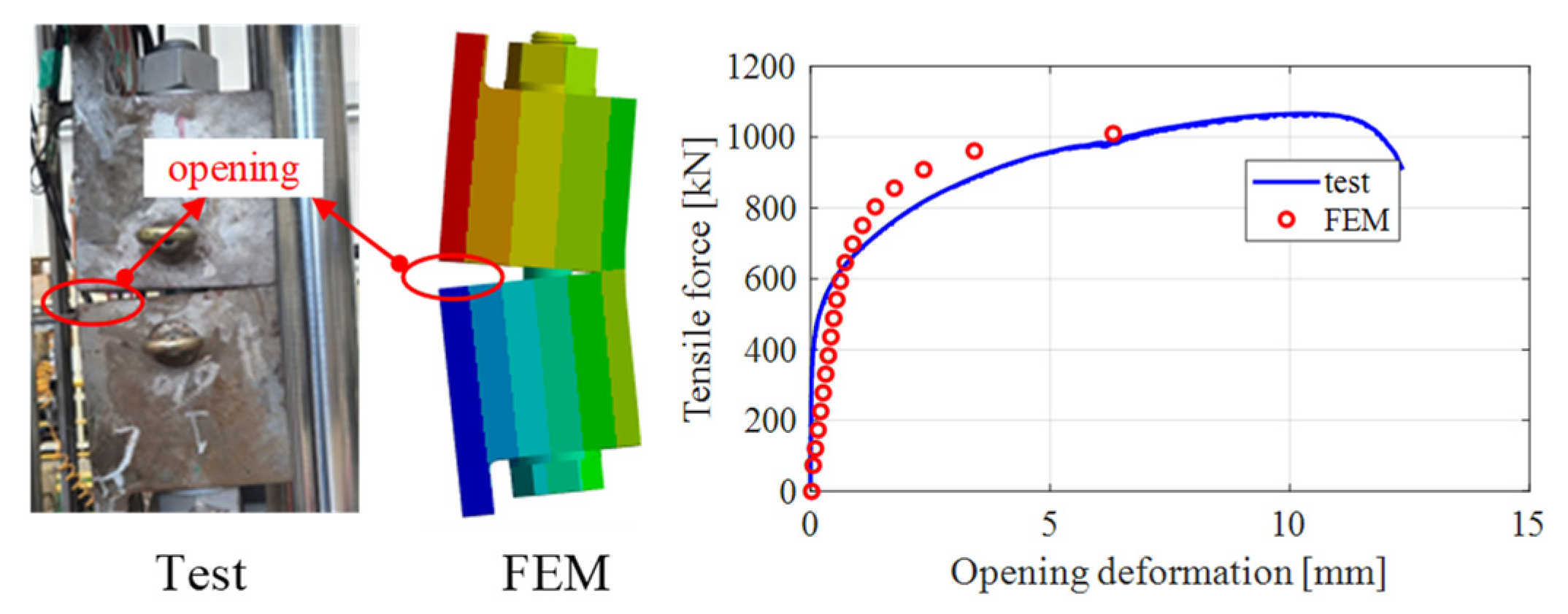

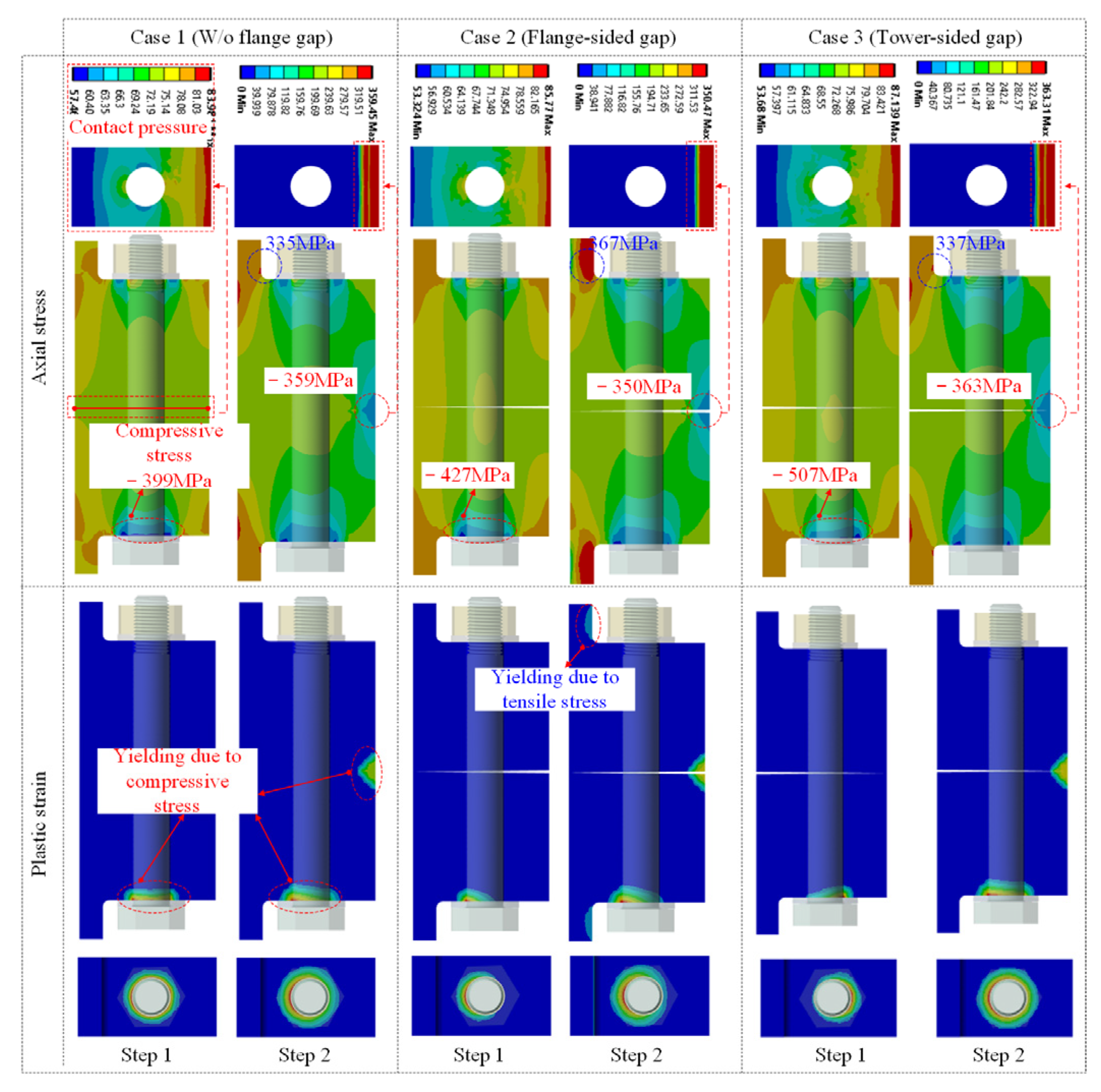


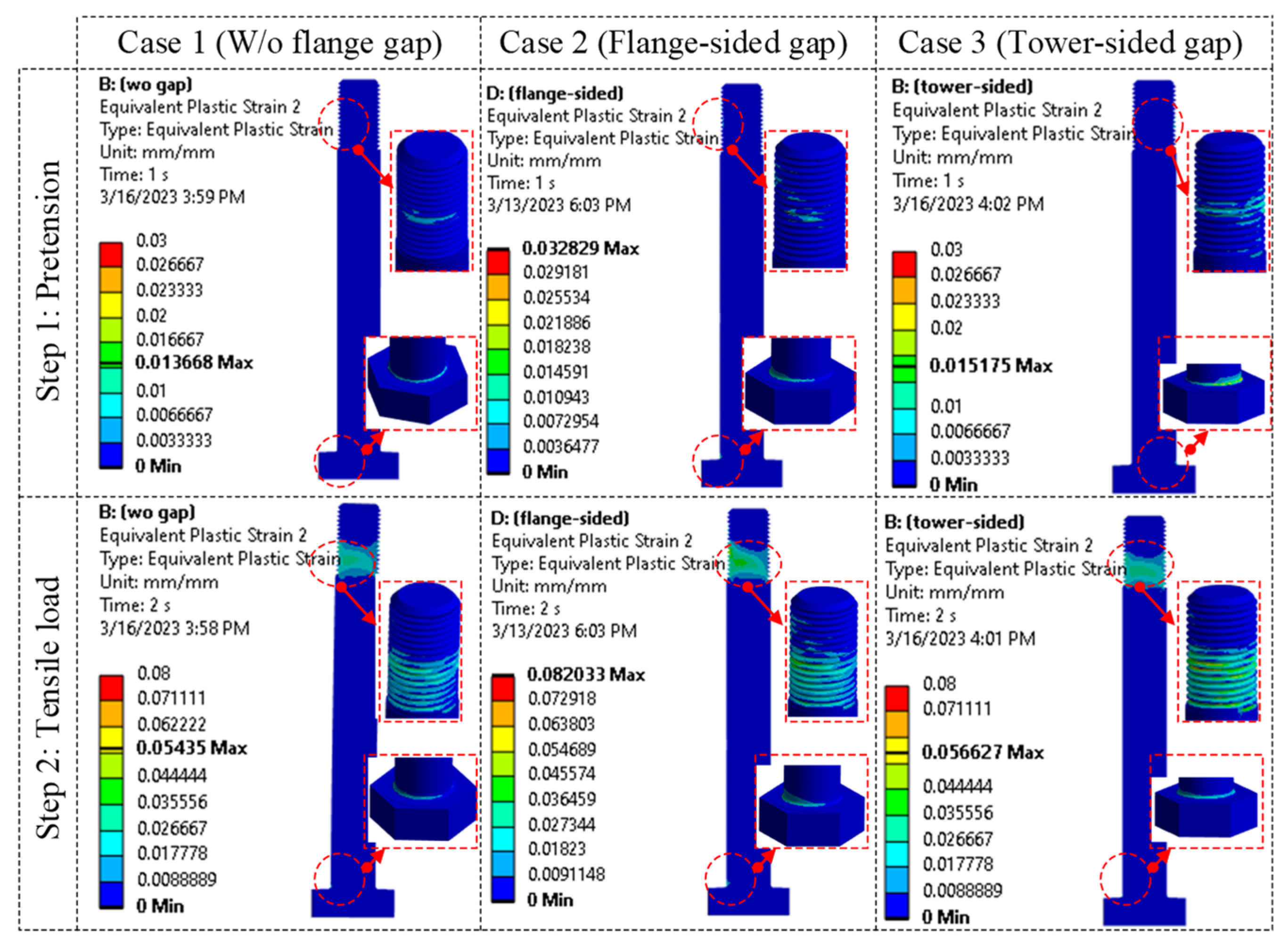
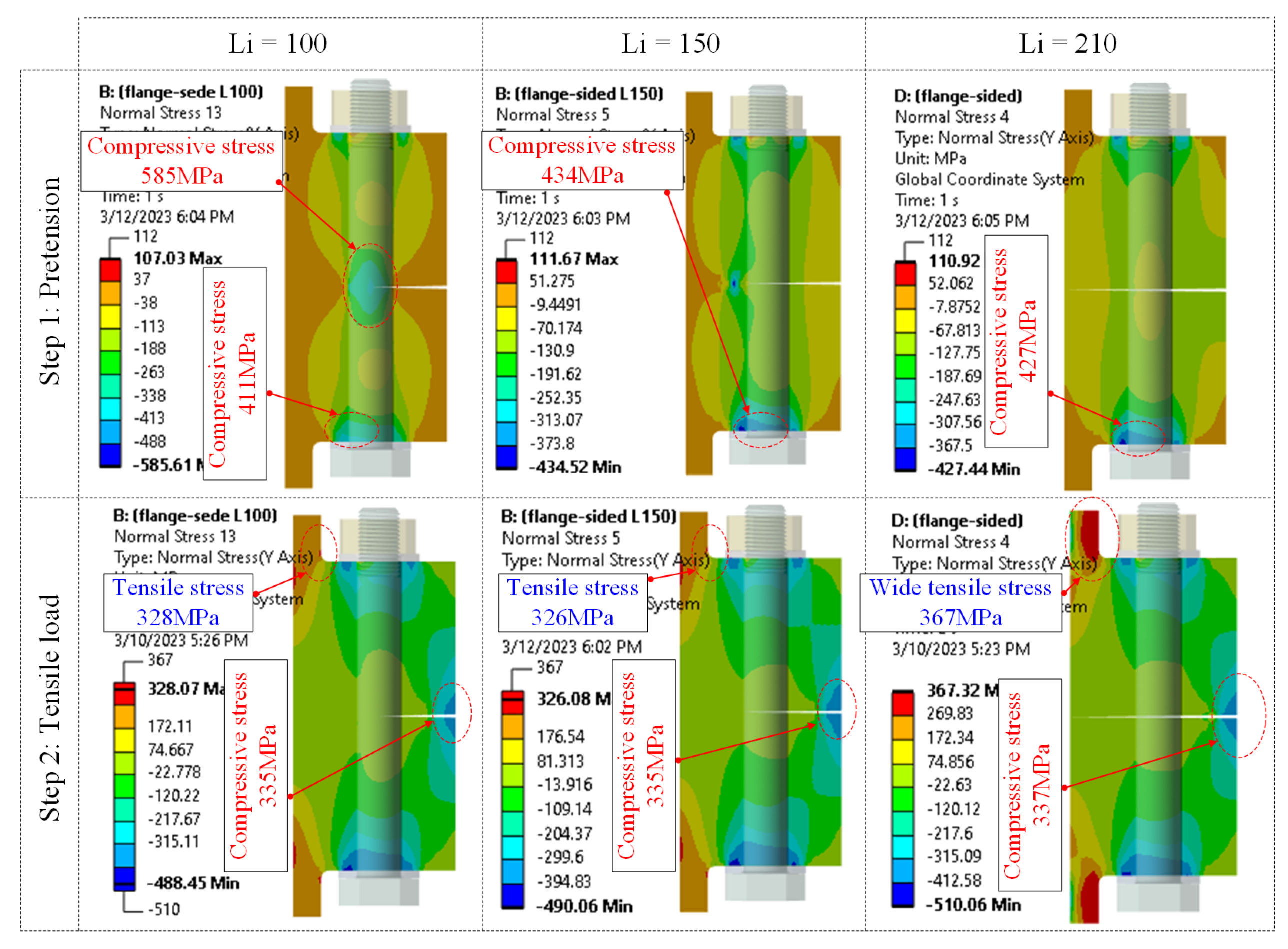

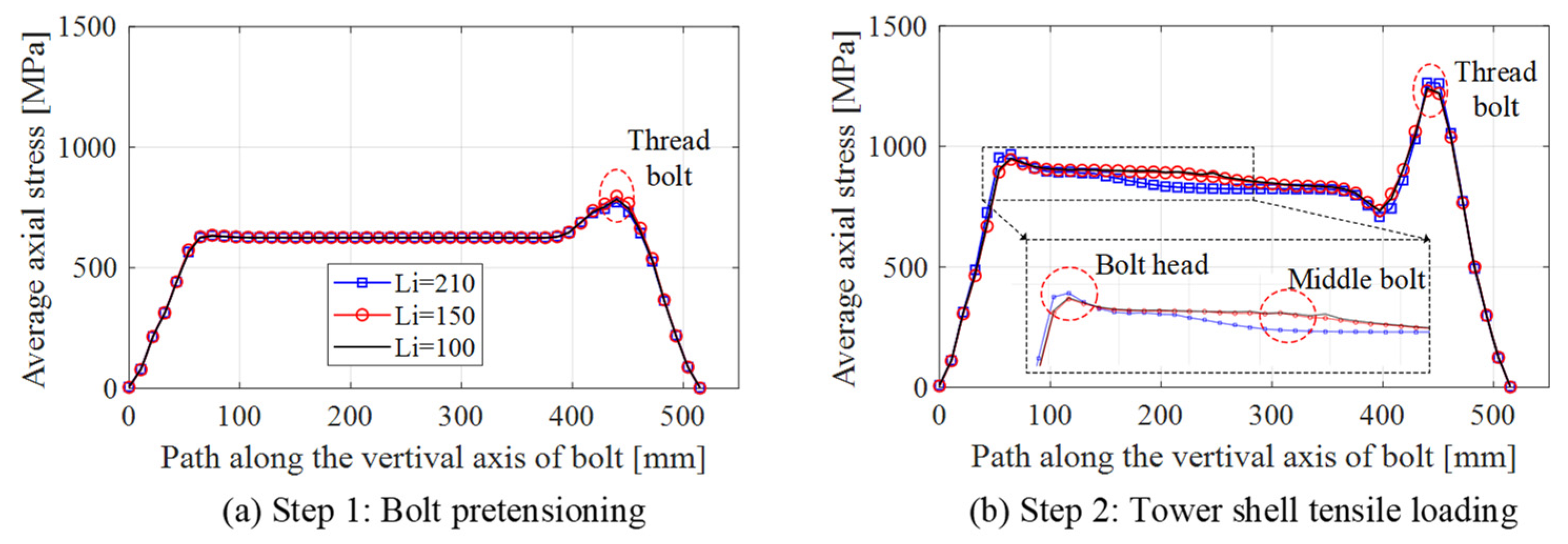
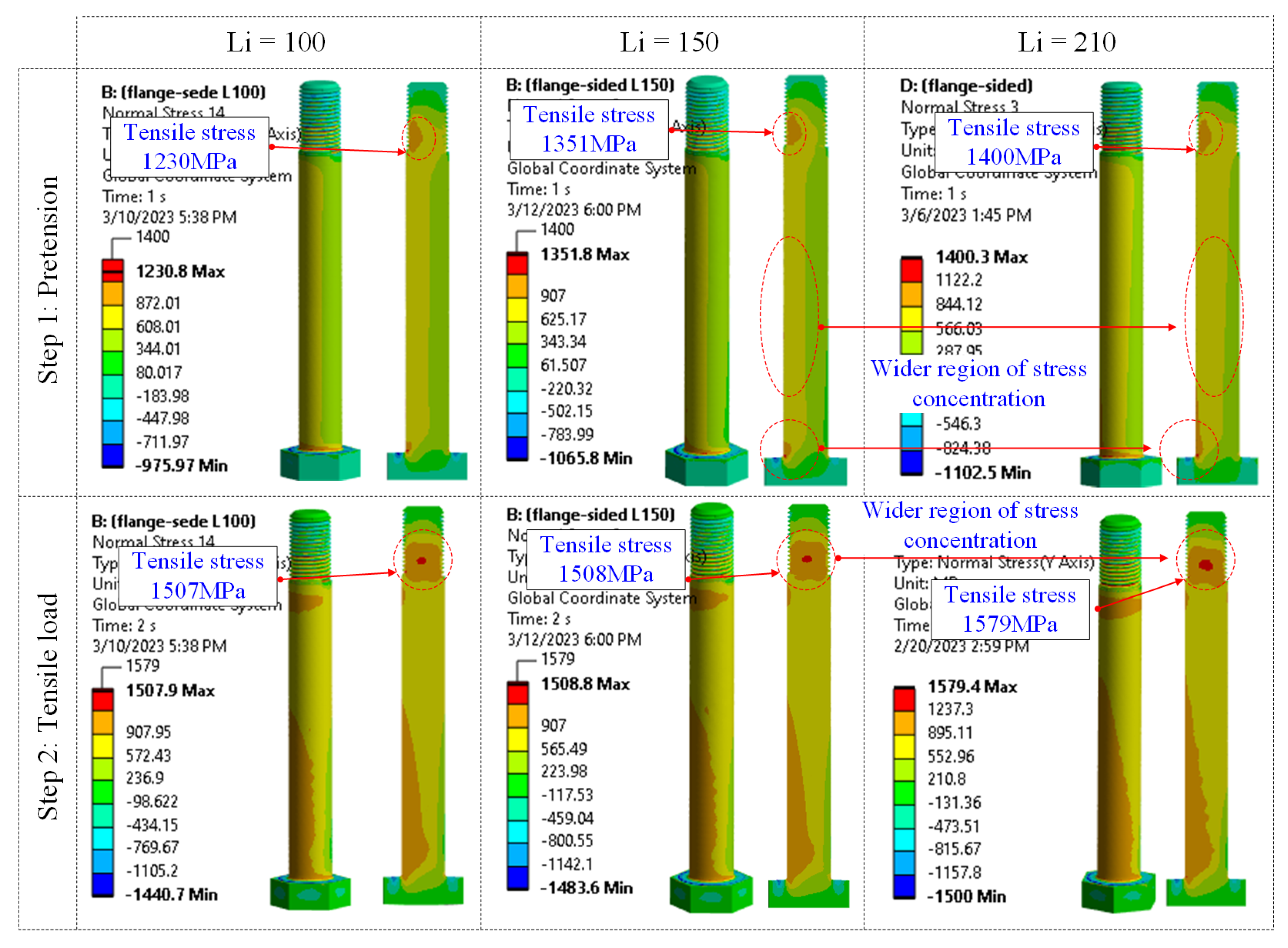

| Bolt | Tower (mm) | Flange (mm) | ||||||
|---|---|---|---|---|---|---|---|---|
| Size | Hole | Length | Length | Thickness | Thickness | * | ** | *** |
| M56 | 59 | 480 | 740 | 36 | 200 | 99 | 93 | 120 |
| Part | Material | Standard | ||||
|---|---|---|---|---|---|---|
| [MPa] | [MPa] | [%] | [%] | |||
| Tower | SS400 | KS B 0802:2021 [22] | 272 | 432 | 38 | 62 |
| Flange | SS400 | KS B 0802:2021 [22] | 310 | 467 | 38 | 67 |
| Bolt | 10.9 | KS B 0801:2022 [23] | 1088 | 1194 | 14 | 53 |
| Parameters | Value |
|---|---|
| 1945.2 | |
| 8309 | |
| K-factor | 0.104 |
Disclaimer/Publisher’s Note: The statements, opinions and data contained in all publications are solely those of the individual author(s) and contributor(s) and not of MDPI and/or the editor(s). MDPI and/or the editor(s) disclaim responsibility for any injury to people or property resulting from any ideas, methods, instructions or products referred to in the content. |
© 2023 by the authors. Licensee MDPI, Basel, Switzerland. This article is an open access article distributed under the terms and conditions of the Creative Commons Attribution (CC BY) license (https://creativecommons.org/licenses/by/4.0/).
Share and Cite
Tran, T.-T.; Park, H.; Lee, D. Structural Behavior of L-Type Flange Joint with Various Flange Flatness Conditions. Energies 2023, 16, 5703. https://doi.org/10.3390/en16155703
Tran T-T, Park H, Lee D. Structural Behavior of L-Type Flange Joint with Various Flange Flatness Conditions. Energies. 2023; 16(15):5703. https://doi.org/10.3390/en16155703
Chicago/Turabian StyleTran, Thanh-Tuan, Hongbae Park, and Daeyong Lee. 2023. "Structural Behavior of L-Type Flange Joint with Various Flange Flatness Conditions" Energies 16, no. 15: 5703. https://doi.org/10.3390/en16155703







